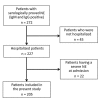Bioclinical Test to Predict Nephropathia Epidemica Severity at Hospital Admission
- PMID: 29774835
- PMCID: PMC6004848
- DOI: 10.3201/eid2406.172160
Bioclinical Test to Predict Nephropathia Epidemica Severity at Hospital Admission
Abstract
We conducted a multicenter, retrospective cohort study of hospitalized patients with serologically proven nephropathia epidemica (NE) living in Ardennes Department, France, during 2000-2014 to develop a bioclinical test predictive of severe disease. Among 205 patients, 45 (22.0%) had severe NE. We found the following factors predictive of severe NE: nephrotoxic drug exposure (p = 0.005, point value 10); visual disorders (p = 0.02, point value 8); microscopic or macroscopic hematuria (p = 0.04, point value 7); leukocyte count >10 × 109 cells/L (p = 0.01, point value 9); and thrombocytopenia <90 × 109/L (p = 0.003, point value 11). When point values for each factor were summed, we found a score of <10 identified low-risk patients (3.3% had severe disease), and a score >20 identified high-risk patients (45.3% had severe disease). If validated in future studies, this test could be used to stratify patients by severity in research studies and in clinical practice.
Keywords: Europe; France; Puumala virus; acute kidney injury; cohort studies; disease severity; hantavirus; hematuria; hemorrhagic disease; hospital admission; leukocytosis; nephropathia epidemica; nephrotoxic drug exposure; prognosis; risk factors; thrombocytopenia; viruses; visual disorder.
Figures



References
-
- Institut Pasteur. Rapports d’activité [cited 2016 Oct 1]. https://www.pasteur.fr/fr/sante-publique/CNR/les-cnr/hantavirus/rapports...
-
- Strady C, Jaussaud R, Remy G, Penalba C. [Hantavirus infections]. Presse Med. 2005;34:391–9. - PubMed
Publication types
MeSH terms
Substances
LinkOut - more resources
Full Text Sources
Other Literature Sources
Medical

